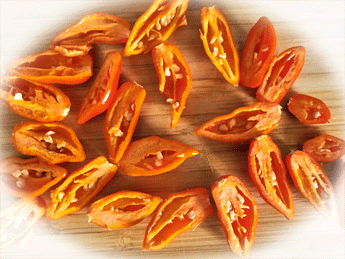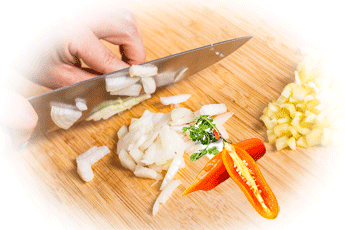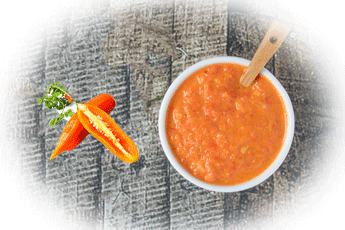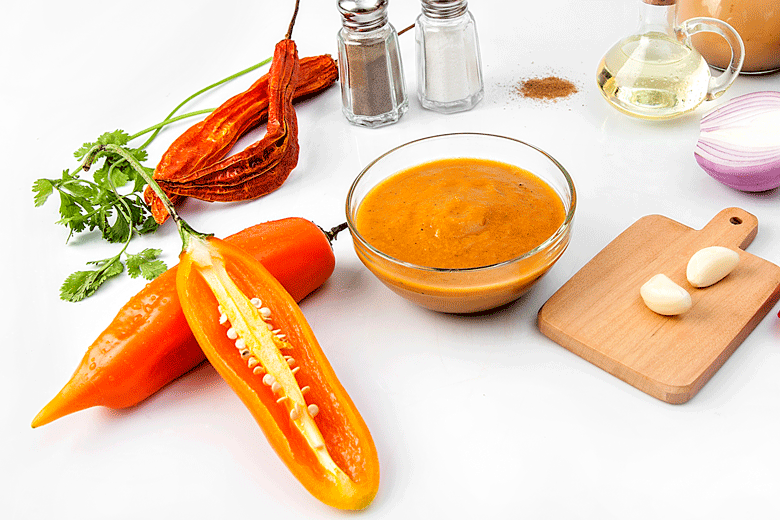Peru’s favourite Chilli
Aji Amarillo is a great tasting Chilli that is massively popular in Peru, where it is used to make many Peruvian dishes like Ceviche (marinated fresh seafood), a Papa a la Huancaina (a potato dish with a spicy sauce) and Causa Rellena (a spicy layered potato dish). In addition to these dishes, Peruvians also make hot sauce with Aji Amarillo. They also use it to make a dipping sauce that is served with roast chicken, french fries, boiled potatoes, and fried plantains.
Recently, I bought some Aji Amarillo Chilli paste. I intend to make a few Peruvian hot sauces and the dipping sauce mentioned above. Usually, I would want to use fresh Chillies to make my sauces, but seeing as this Chilli growing season has only just started, that will be out of the question. At the moment, the Chilli paste will just have to do for now.
season has only just started, that will be out of the question. At the moment, the Chilli paste will just have to do for now.
The Aji Amarillo paste I will use is authentic and was made in Peru. Indeed, it is even thickened with Tara gum. This is a thickener uniquely Peruvian. It is an alternative to Guar gum and is made by grinding the endosperm of seeds from a tree native to Peru – the Tara tree.
Because the paste is already thickened, I will only need to add other ingredients like vinegar, garlic, onions, salt and spices to make the hot sauces. I might also add a bit of Chilli powder and a sweeter sugar to balance the flavours. I aim to make the hot sauces carb friendly and sugar free by using Xylitol or Erythritol. The dipping sauce does not need to be sweetened
The dipping sauce combines sour cream, feta cheese, Aji Amarillo Chillies and citrus to make a creamy sauce that is great for serving with various dishes. It is also fantastic as a dip for a snack table, where it can be eaten with potato crisps, nachos or flat breads
Okay, so let’s make some Aji Amarillo sauces!
A dipping sauce and two hot sauces
Aji Amarillo dipping sauce
To make the aji Amarillo dipping sauce, I needed 2 medium onions, half a cup of mayonnaise, a quarter of a cup of sour cream, a quarter cup of feta or ricotta cheese, four tablespoons of Aji Amarillo paste, one tablespoon of tomato ketchup, a quarter cup of freshly squeezed lime juice and salt & pepper to taste
Now it was simply a matter of chopping the onions and placing them in a blender with the rest of the ingredients. After blending everything together, I seasoned the dip with salt and pepper. I didn’t do so on this occasion, but the flavour of the sauce could have been improved if I had refrigerated it for twenty-four hours before serving
If I wanted to make this sauce with fresh Aji Amarillo’s, I would have fried them until they were soft in a little olive oil, and used the same procedure to make it
I served this sauce as an alternative to the green sauce (aji Verde). I usually serve with Pollo al Brasa (a popular Peruvian Roast Chicken dish). I could also have served it as an appetiser with pita bread or freshly baked French loaf. Either way, this sauce is a definite winner. It is definitely a sauce I had added to my best recipe list
Now on to the hot sauces
For the first hot sauce, I needed six tablespoons of Aji Amarillo paste, half a cup of white grape vinegar, a tablespoon of Xylitol, half a teaspoon of turmeric and a quarter teaspoon of salt. I wanted to keep it as simple as possible, so that the flavour of the Chillies could come through
To make it, I added all the ingredients into a blender. I then blitzed everything until it was well combined. As a final touch, I added a pinch of Scotch bonnet flakes. From there, I poured the sauce into sterilized bottles and sealed them. And there it was, job done
The second sauce will be a little more complicated. For this hot sauce, you need a medium onion, two teaspoons of garlic paste, twelve tablespoons of Aji Amarillo paste, half a cup of apple cider vinegar, half a cup of water, two tablespoons of Erythritol, half a teaspoon of salt and a pinch of Scotch bonnet flakes
Firstly, I chopped the onions finely. I then fried them in rapeseed oil until they softened and had become translucent. I then added the garlic paste and the rest of the ingredients, and brought the mixture to the boil. Once it was boiling, I allowed it to simmer for ten minutes. I allowed the sauce to cool, and then placed it in a blender. The mixture was blitzed until all the ingredients were well combined. Finally, I poured the sauce into some sanitised bottles with a funnel. The only thing left to do was screw on the caps and label the bottles. With that accomplished, I allowed the hot sauce to cool and then placed it in the fridge.
Definitely another winner!
Final note
Even after making the hot sauces and the dipping sauce, I still had half a bag left of the paste. I decided to preserve it in two ways. The first method I used was to pour the paste directly into an ice tray to make Aji Amarillo ice cubes, and placed it in the deep freeze. Chilli ice cubes are a convenient way to add Chilli flavour and pungency to dishes. Next time I need to use Aji Amarillo in a recipe, all I need to do is add cubes directly into the pot. I can see me using it to make dishes like Cau- Cau, which is a Peruvian dish made with tripe
The second method was by pouring about half a cup of paste into small Ziplock bags, and then freezing the paste. I will use these to make more hot sauces in the future. One hot sauce I will experiment with will have mango as an ingredient. I think the fruity, berry like flavour of Aji Amarillo will complement the mango. Its bright orange yellow colour will also add a nice colour dimension to the sauce


